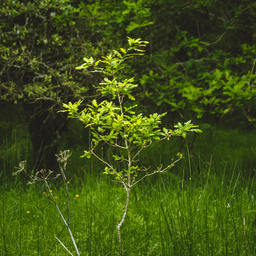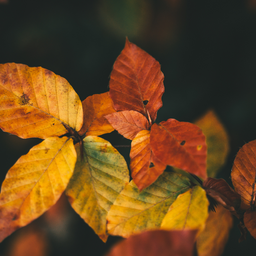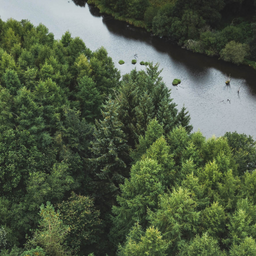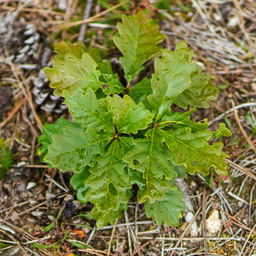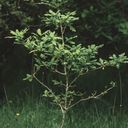
How much CO2 does a tree absorb?
This big question has a big answer. So hold onto your thinking hats and come with EcoTree to explore it.
A tree absorbs approximately 25kg of CO2 per year
We cheated and gave you the short answer first! It’s based on the estimate that a cubic metre of wood absorbs just under a ton of CO2.
But really a tree absorbs anywhere between 10 and 40kg of CO2 per year on average, depending on a whole host of factors. And it’s all those complex variables that make working out how much CO2 a tree absorbs so interesting. So let’s start breaking it down. For fun!
A little word about calculating CO2 before we start
We’ve developed our own scientific methodology to calculate the average absorption of our trees, verified by Bureau Veritas. We’ve done it to help you quantify your contribution towards global carbon neutrality and go on a bit about this in our Carbon Manifesto. But now that’s said, let’s get to it!
The chemical composition of wood
The chemical composition of wood doesn’t vary much from tree to tree. (Hooray, one thing that doesn’t change massively in all this!)
Cellulose (C6H10O5)n is the main component of the cell walls of trees. It’s a chain of glucose molecules that the tree produces through photosynthesis. We’ll look at how in a minute. Cellulose makes up 50-80% of wood.


50% carbon

42% oxygen

6% hydrogen

1% nitrogen

1% mineral matter
Photosynthesis is really cool
From the Greek
for « Light »
Greek for
« Putting together »
Step 1
Plants absorb water and minerals through their roots to make sap.
Step 2
The sap travels through the tree to the leaves. The leaves absorb CO2 and light.
Step 3
The leaves use chlorophyll and the sun’s energy to convert CO2 & water into glucose.
Step 4
Oxygen is released and the glucose nourishes the tree, transported by the sap.
Purifying the air as it grows
Amazingly, to grow by one cubic metre, a tree will purify nearly one million cubic metres of air of its CO2 (assuming 0.03 to 0.04% of air is CO2).1 Trees are the best.
How much water is there in a tree?
How much water is there in a tree?

How to calculate the carbon in a tree

Now let’s work out how much CO2 a tree absorbs
To do it, let’s use an example. We’ll imagine a 1000kg tree with 100% humidity. Now we know this tree is 500kg water and 500kg dry mass. And we know that 47.5% of that dry mass is carbon. That’s 237.5kg.
Thanks to molar mass ratios, we can break CO2 down and find that it takes 3.67kg of CO2 to create 1kg of carbon in the tree. That’s because carbon has a molar mass of 12 and oxygen 16. Combined as CO2 that’s 44. And 44/12 = 3.67.
So for our tree example, 237.5 × 3.67 = 871.63kg of CO2. Hooray! If we want to know how much it’s absorbed per year, we need to know the age. If it weighs a ton standing, we can guess it’s 30 to 40 years old. So if we assume it's 35 years old, this big boy absorbed 25kg of CO2 per year.
1,000kg of wood
500kg of dry wood
237.5kg of carbon
871.63kg of CO2 absorbed
How the species of the tree affects CO2 absorption
All our trees are great at absorbing CO2!
All our trees are great at absorbing CO2!

When do trees
absorb most CO2?
Young trees or old trees? That is the question scientists are still debating. In their youth, trees grow faster so they absorb CO2 quicker, but in their old age their density is much greater so they can absorb more CO2, as this 2014 study in Nature demonstrates. As for our trees, the ones below will give you the most bang for your buck when it comes to CO2 absorbed over their lifetimes.
A tree absorbs about 25 kg of C02 anually.
Our carbon capture calculations have been verified by world-renowned Bureau Veritas. So when you own a tree, you can track the carbon captured over its whole lifetime!
In the end, most of the figures put forward should be taken with great care, but they give an average range of 10 to 40kg of CO2 absorbed per tree per year over a lifetime.
Ready to make an impact on CO2?
Ready to make an impact on CO2?

1 Vade-mecum du forester , p. 67, XIVth edition, 2016, Forestry Society of Franche-Comté and Eastern Provinces
2 Patrick Vallet's thesis is titled Impact of different silvicultural strategies on the "carbon sink" function of forest stands. Modeling and simulation at the plot scale .

